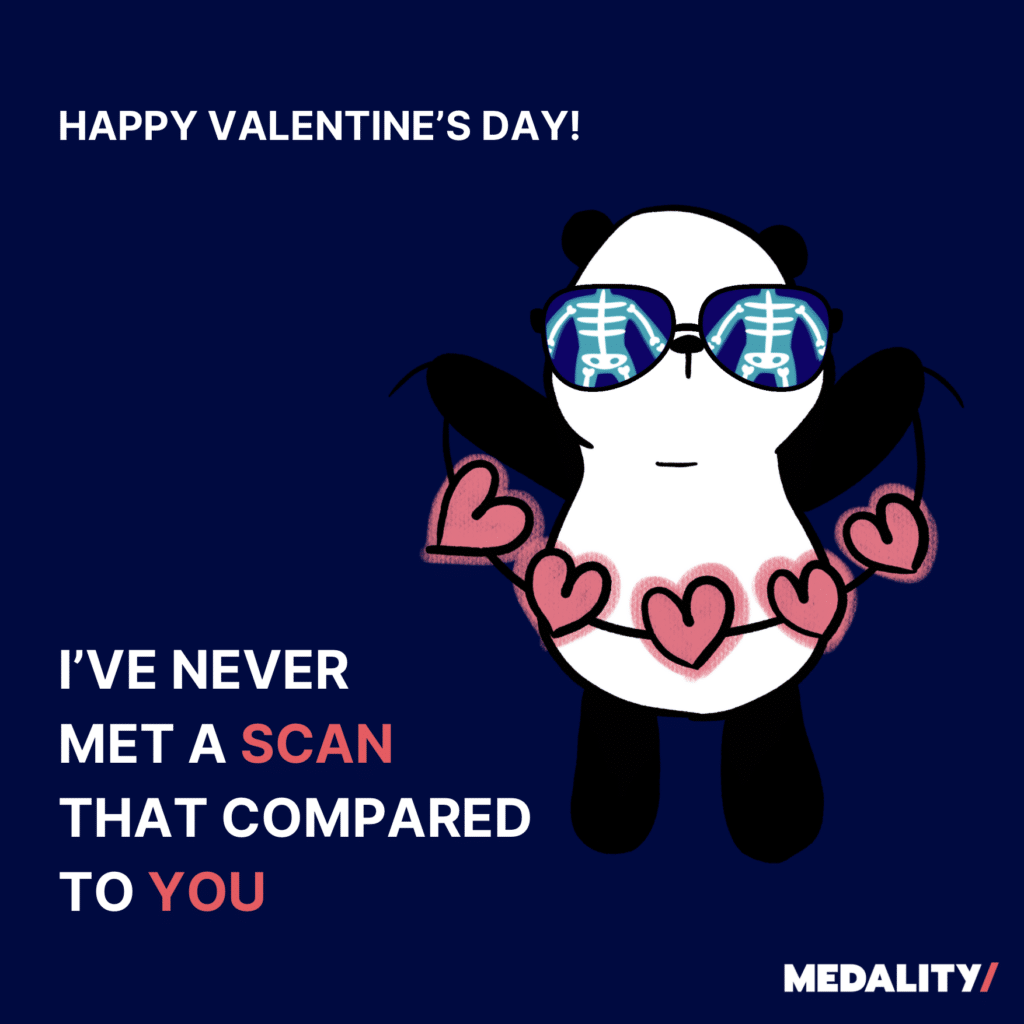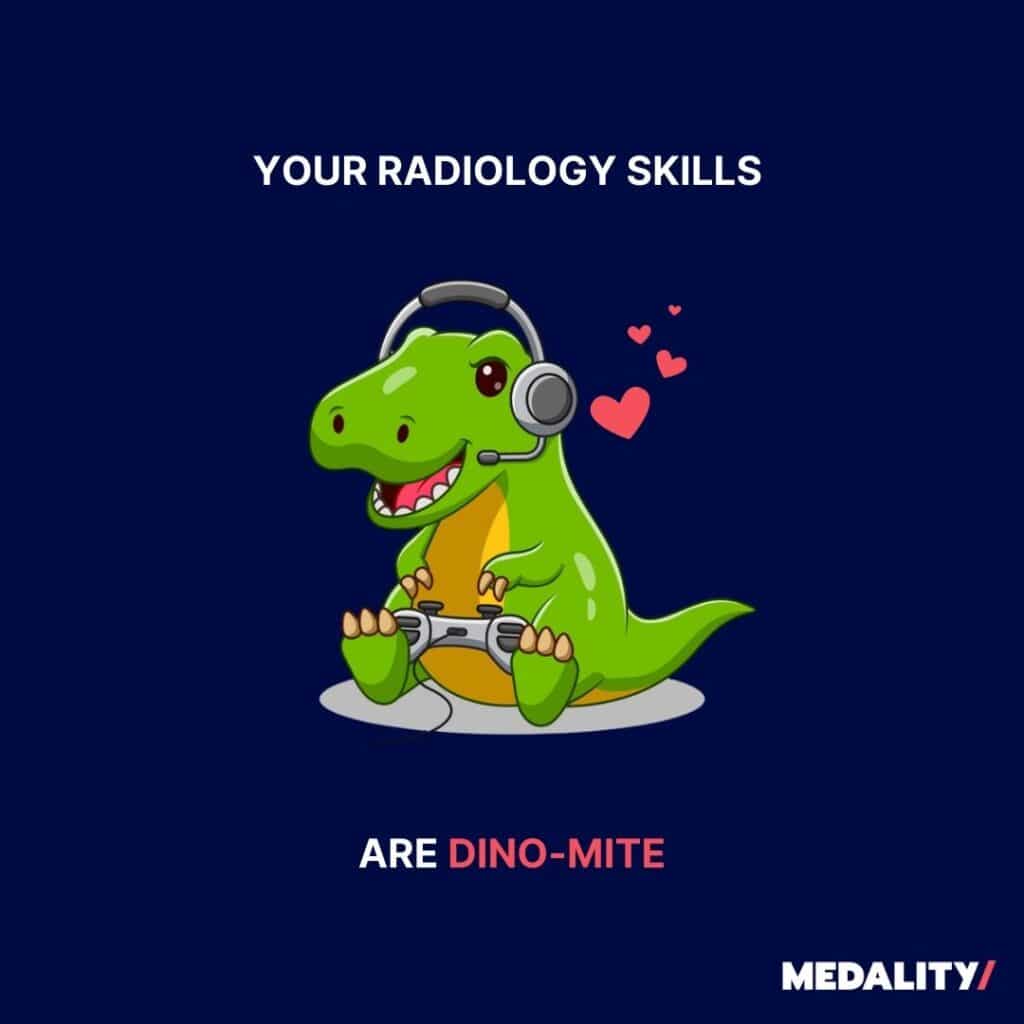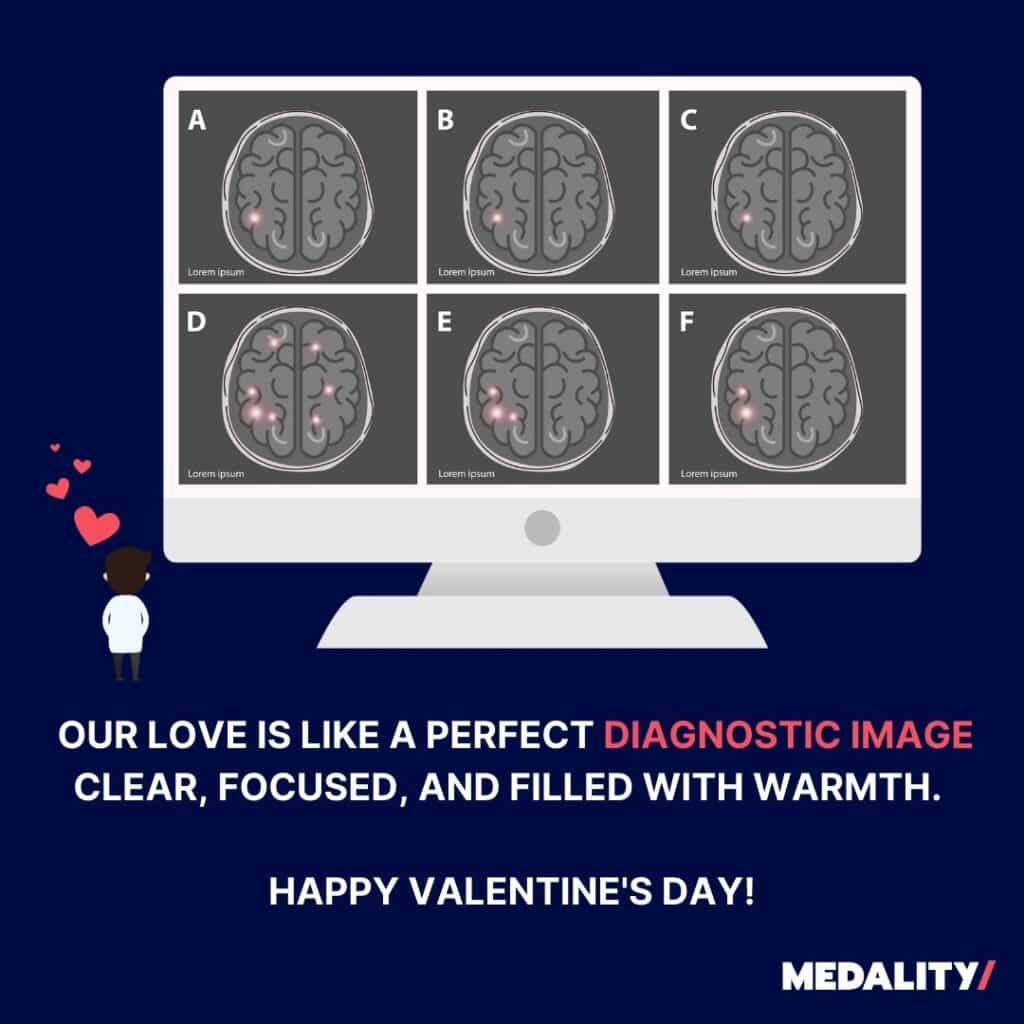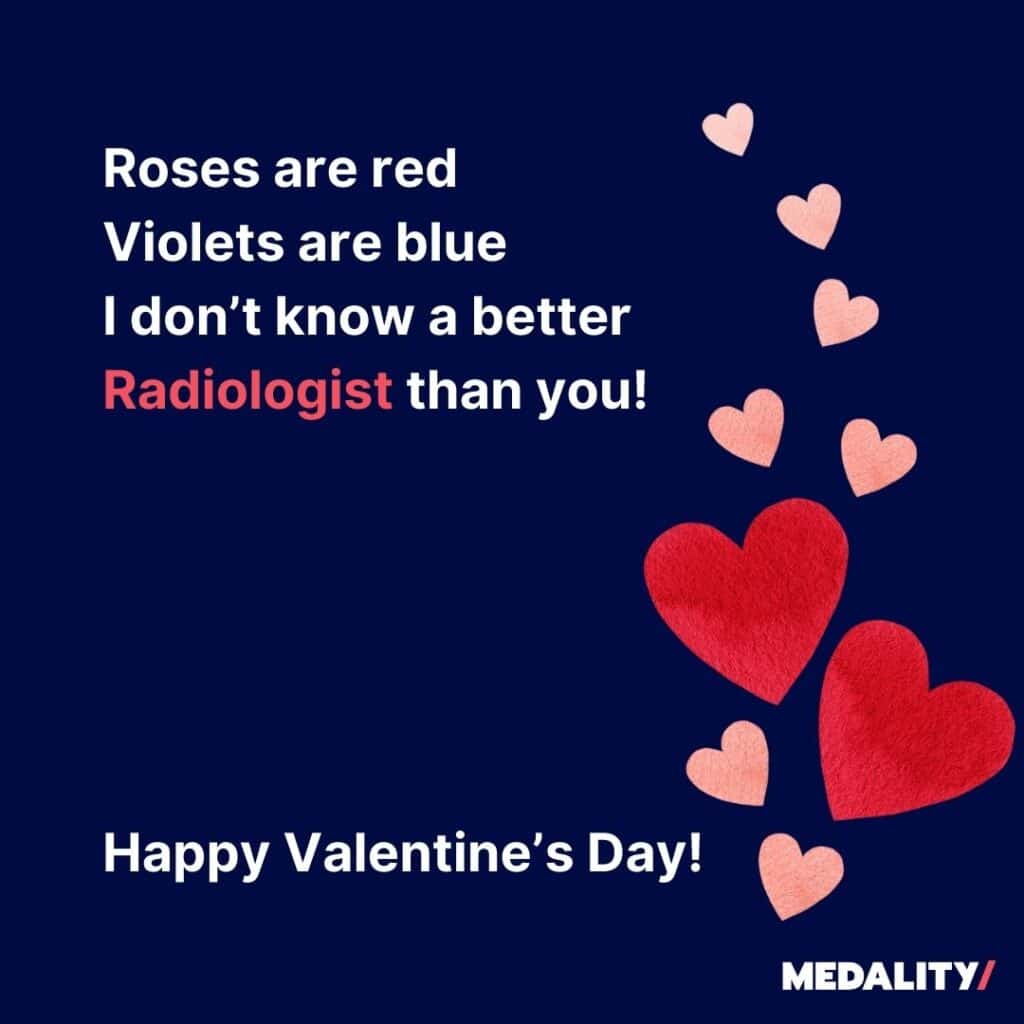The shortage of radiologists is well-known. Has the radiologist training and education system — with its heavy focus on subspecialization — played a role?
Learn more about radiology’s workforce challenges and their potential solutions in this Imaging Wire Show interview featuring Medality CEO and Co-Founder, Daniel Arnold, and Head of Educational Strategy and Operations, Deanna M. Heier, PhD.
October is Breast Cancer Awareness Month, a time when stories of hope, resilience, and unwavering dedication come to the forefront. At Medality, we are proud to support radiologists in their journeys to make a real difference in the lives of their patients and advocate for a better future. This month, we invite you to reflect on the remarkable role you play in the fight against breast cancer and to explore new tools that can enhance your ability to diagnose, treat, and ultimately save lives.
Everyday, breast imaging experts work tirelessly to unravel the complexities of breast cancer. They bring to life the transformative potential of technology and medicine in diagnosing and treating breast cancer with precision. This October, we recognize the contributions of experts like Dr. Rachel Brem, Dr. Petra Lewis, Dr. Lisa Mullen, Dr. Emily Conant, Dr. Ryan Woods, Dr. Emily Ambinder, Dr. Robyn Roth, Dr. Priyanka Handa, and Dr. Carolynn DeBenedectis.
These leaders in breast imaging are dedicated not only to their patients but also to educating the next generation of radiologists. They share their time and expertise so others can learn from real-world cases, reflect on diagnostic challenges, and apply new insights to improve patient outcomes.
Imagine walking into a reading room and opening a case file for a 32-year-old woman with a palpable breast mass and a family history of breast cancer. You feel the weight of responsibility on your shoulders—the outcomes you report could significantly alter the course of her life. Is the mass benign? Is it malignant? Does she have dense breast tissue? Should she have an ultrasound?
With courses like Breast MRI Expert Case Review and Radiology Diagnostic Breast Imaging: Mammo, Tomo, & Ultrasound, we aim to equip you with the skills to answer these questions confidently and accurately. These courses allow you to step into a virtual reading room, face complex cases, and develop the knowledge to recognize subtle abnormalities and interpret advanced imaging modalities.
Click here to access our entire Breast Imaging library.
This month, radiologists can also join Dr. Amy Patel on October 17 for a Noon Conference on the new FDA breast density reporting guidelines. This discussion, titled “Breast Density: Insights and Cases from Past, Present, and Future,” is designed to prepare radiologists for the significant regulatory changes affecting breast imaging. With her guidance, radiologists will be able to understand these changes but also learn to integrate them into their practice to enhance patient care and compliance.

Click here to access our entire free Breast Imaging Noon Conference library.
Breast cancer affects millions of women and men worldwide. By continually learning and advancing your skills, you’re joining the fight against this disease and making a difference in your patients’ lives every single day.
Let this Breast Cancer Awareness Month be a reminder of the powerful role you play. Take the time to explore our resources, learn from experienced mentors, and challenge yourself with cases that will make you a more skilled and compassionate radiologist. Together, we’re writing a story of hope, expertise, and resilience.
Prostate cancer is the second leading cause of cancer death in men worldwide. As we embark on Prostate Awareness Month, it’s an important time to reflect on the critical role radiologists play in the early detection, screening, management, and ongoing treatment of this deadly disease.
Radiologists are at the front lines of prostate cancer detection playing a crucial role in diagnosing and staging the disease. With the increased use of advanced imaging modalities, radiologists can provide more detailed information about prostate lesions, improving the accuracy of biopsies and guiding more targeted treatment plans. Continuing education in these cutting-edge technologies is essential for radiologists so they can help with the early detection, screening, management and ongoing treatment of this life-threatening disease.
That’s why, we at Medality (formerly MRI Online) are committed to transforming the way radiologists learn and thrive by designing courses that help practicing radiologists and trainees develop the skills needed to better detect, diagnosis and manage prostate cancer.
The U.S. Centers for Medicare and Medicaid Services (CMS) announced on July 11 a significant advancement in the fight against colorectal cancer: the proposal to cover CT colonography screening. This minimally invasive screening tool marks a pivotal step in providing more accessible and less intrusive cancer screening options for Medicare patients.
CT colonography radiology offers a powerful – and accurate – alternative for detecting precancerous polyps without the need for anesthesia. The move promises a more comfortable experience for patients while maintaining the effectiveness of traditional diagnostic methods.
In a prepared statement, the American College of Radiology (ACR) praised the move, calling it a “big step forward in providing Medicare patients access to a minimally invasive CRC screening tool that can detect precancerous polyps and does not require anesthesia.”
Radiologists and radiology practices must prepare for an expected increase in imaging volumes following this announcement by becoming more proficient in virtual colonoscopy. CT colonography courses and training programs can provide the resources needed to gain expertise in this advanced screening technique to meet increased demand.
Preventative healthcare includes colorectal cancer screenings aimed at early detection and intervention. Current guidelines recommend several traditional screening methods, including colonoscopy, fecal occult blood tests (FOBT), and sigmoidoscopy. These methods have proven effective in identifying colorectal cancer and precancerous polyps, reducing the incidence and mortality rates associated with the disease.
Colonoscopy is the gold standard. It involves a thorough examination of the entire colon using a flexible tube with a camera. Although effective, it requires bowel preparation, sedation, and recovery time, which deters some patients from undergoing the procedure.
In contrast, the newly proposed virtual colonoscopy offers a minimally invasive alternative. This innovative screening method isn’t new. It has existed for over 30 years and boasts numerous advantages over traditional colonoscopy.
CTC requires less patient preparation and eliminates the need for sedation. Virtual colonoscopies also lower the risk of complications such as bowel perforation.
The CMS’s recommendation of CT colonography screening represents a significant shift toward patient-friendly, accessible options.
As the Centers for Medicare and Medicaid Services propose including CT colonography as a covered screening option for colorectal cancer, radiologists and radiology practices must adapt. Comprehensive training is essential to support this transition.
Medality offers a comprehensive CT colonography course led by esteemed experts Dr. Judy Yee of Montefiore Medical Center and Dr. Kevin Chang from Boston Medical Center. The virtual colonoscopy course equips radiologists with the necessary skills and knowledge to proficiently conduct and interpret CTCs.
Radiologists can take the online course at their convenience to educate themselves about every facet of CT colonography screenings. Key components of the course include:
The proposed inclusion of CT colonography as a Medicare-covered screening option marks a significant shift in the fight to detect colorectal cancer early.
As this minimally invasive technique gains prominence, it is imperative for radiologists and radiology practices to stay ahead of the curve. CT Colonography courses offer an invaluable opportunity for medical professionals to gain comprehensive knowledge and practical skills in this emerging modality.
June is Alzheimer’s and Brain Awareness Month, a time dedicated to raising awareness and understanding of Alzheimer’s disease and other brain disorders.
Radiology is at the forefront of diagnosing neurodegenerative diseases like Alzheimer’s and other forms of dementia. Advanced imaging techniques allow us to detect early signs of brain disorders, track disease progression, and evaluate the effectiveness of treatments.
This critical work can dramatically improve patient outcomes and enhance the quality of life for those affected by these conditions. That’s why, we at Medality, formerly MRI Online, are committed to transforming the way radiologists learn and thrive by creating courses that will give practicing radiologists and trainees the knowledge and skills needed to diagnose and manage these complex neurodegenerative diseases effectively.
Radiologists play a critical role in diagnosing and treating medical conditions through advanced imaging techniques. Given their importance, it’s natural to wonder how much they make, especially if you’re considering a career in this field or are already established and looking to make a move to a higher-paying state.
Radiologist salary can vary significantly across the U.S. Geographic location, level of education and training, years of experience, and any specialties factor into the range of salaries radiology professionals can expect.
Beyond location and subspecialties, factors like working in private practice versus an academic setting and working in leadership roles within the industry can affect a radiologist’s salary.
Medscape, an organization providing medical information for clinicians and medical scientists, created a comprehensive compensation report to help professionals compare their radiology salary to that of their peers in neighboring states.
According to the findings, radiologists were the seventh highest-paid medical specialists in the U.S. behind plastic surgery, orthopedics, cardiology, urology, gastroenterology, and otolaryngology. The average income for radiologists was $437,000, reflecting a 10% increase in salaries and other types of compensation.
While the report indicates that radiologist salary rose overall, 42% of practitioners experienced a decrease in their wages, primarily due to the pandemic.
Medality has broken down the average radiologist salary by state based on data from the U.S. Bureau of Labor Statistics, Medscape’s salary report, and real-time salary information from ZipRecruiter to provide an overview of compensation radiologists can expect from each state.
| STATE | ANNUAL SALARY | HOURLY WAGE | ||
| New York | $409,782 | $197.01 | ||
| Pennsylvania | $375,232 | $180.40 | ||
| New Hampshire | $366,923 | $176.41 | ||
| New Jersey | $361,359 | $173.73 | ||
| Wyoming | $357,458 | $171.86 | ||
| Washington | $356,971 | $171.62 | ||
| Wisconsin | $354,412 | $170.39 | ||
| Massachusetts | $354,403 | $170.39 | ||
| Alaska | $353,475 | $169.94 | ||
| Oregon | $350,612 | $168.56 | ||
| Indiana | $350,053 | $168.30 | ||
| North Dakota | $349,969 | $168.25 | ||
| Hawaii | $343,173 | $164.99 | ||
| Arizona | $342,816 | $164.82 | ||
| New Mexico | $340,684 | $163.79 | ||
| Colorado | $338,431 | $162.71 | ||
| Minnesota | $338,345 | $162.67 | ||
| Montana | $337,650 | $162.33 | ||
| Nevada | $334,220 | $160.68 | ||
| Alabama | $333,433 | $160.30 | ||
| South Dakota | $330,759 | $159.02 | ||
| Vermont | $330,227 | $158.76 | ||
| Ohio | $330,038 | $158.67 | ||
| Rhode Island | $324,751 | $156.13 | ||
| Iowa | $320,856 | $154.26 | ||
| Delaware | $320,425 | $154.05 | ||
| Connecticut | $319,832 | $153.77 | ||
| Virginia | $316,719 | $152.27 | ||
| Mississippi | $315,420 | $151.64 | ||
| Tennessee | $315,110 | $151.50 | ||
| Utah | $313,490 | $150.72 | ||
| Illinois | $312,546 | $150.26 | ||
| Georgia | $310,614 | $149.33 | ||
| Maryland | $310,550 | $149.30 | ||
| California | $309,612 | $148.85 | ||
| Nebraska | $304,590 | $146.44 | ||
| Maine | $303,184 | $145.76 | ||
| Missouri | $300,944 | $144.68 | ||
| South Carolina | $297,986 | $143.26 | ||
| Kansas | $296,902 | $142.74 | ||
| Idaho | $295,590 | $142.11 | ||
| Louisiana | $295,401 | $142.02 | ||
| Oklahoma | $294,971 | $141.81 | ||
| Texas | $293,064 | $140.90 | ||
| North Carolina | $291,836 | $140.31 | ||
| West Virginia | $289,796 | $139.33 | ||
| Kentucky | $281,024 | $135.11 | ||
| Michigan | $280,371 | $134.79 | ||
| Florida | $274,889 | $132.16 | ||
| Arkansas | $266,703 | $128.22 |
One quick glance at the radiology salary by state chart reveals the variation in wages based on location. Radiologists in New York enjoy an average annual salary of $409,782, while their counterparts in Arkansas earn $143,079 less for doing the same work.
Cost of living plays a role in the disparities. However, it’s not the only reason why location impacts annual salary for these healthcare professionals.
Supply and demand factors in as well. The Association of American Medical Colleges (AAMC) projects a radiologist shortage between 37,800 and 124,000 between now and 2034. Wyoming has one of the worst shortages, with an estimated 38.8 radiologists for every 100,000 Medicare enrollees in the state. The state offers a competitive wage – $357,458 annually – to attract and keep radiologists. They’re the seventh highest-paying state in our salary report.
Next to location, experience is the biggest influence on annual wages for radiologists. More experienced radiologists offer benefits such as faster workflows and greater proficiency at interpreting complex medical images thoroughly and accurately.
With experience comes opportunities for advancement in the field, including leadership and management roles. Department chairs and chief medical officers are among the positions that typically come with higher salaries to accommodate for greater responsibilities.
Radiologists with exceptional expertise can contribute leadership within national organizations such as the Radiological Society of North America and the Association of Educators of Imaging and Radiological Sciences.
Completing a Doctor of Medicine (M.D.) or Doctor of Osteopathic Medicine (D.O.), followed by completing a residency program in radiology, is the level of education needed to earn the highest radiologist salary. It takes more than a decade for most to fulfill these requirements.
After meeting the educational requirements for becoming a radiologist, seeking board certification is the final step. While board certification isn’t required to work as a radiologist, it’s a valuable credential that can increase earnings.
Radiologists have the option of completing a fellowship in a subspecialty of radiology, which can further boost income levels. Roughly 90% of radiologists complete a fellowship that provides more advanced training in a specialized area.
Some of the most common radiology fellowships that come with higher wages include:
Most fellowships last one to two years, during which time a radiologist can enhance their skills and subspecialties in high demand. The greater the demand, the higher the wages.
Private practice radiologists tend to earn higher annual salaries than their academic counterparts because their compensation is tied to productivity. The more patients they see and procedures they complete, the higher their income.
Some private practices offer bonus structures or profit-sharing models that reward radiologists for meeting or exceeding targets or for otherwise contributing to the practice’s financial success.
Radiology educators average annual salaries range between a low of $60,654 in North Carolina to a high of $96,206 in New York.
Several key elements affect radiologist salary. Cost of living, demand for healthcare services, and geographic location are among the factors that impact salaries the most.
While some radiologists may gravitate toward opportunities in the states offering the highest wages, it’s essential to consider other factors. Quality of life and opportunities for professional growth and advancement are attractive options for some radiologists that may influence their career path more strongly than income.
To choose the best option for your radiology career, arm yourself with quality market intelligence and then develop a holistic approach to total compensation.
Studying for the radiology boards? Join the Medality team and our world-class radiologists for some fast-paced case reviews covering high-yield topics from the ABR Core Exam blueprint. From February through May, you’ll learn from top faculty from around the country in 10 live one-hour case reviews, covering high-yield topics from the ABR Core Exam blueprint. And don’t worry if you can’t make it live – all you have to do is register and you’ll receive access to the full replay library though the end of 2024.
To celebrate our new Case Crunch Core Review series, we decided to launch a giveaway to help fuel your studying and your learning! Follow the instructions below to be entered to win a DoorDash Gift Card and a Premium membership to MRIOnline.com.
Enter to win:
Contest is open worldwide and ends on Sunday, May 12, 2024 at 11:59 ET. Winners will be chosen at random and contacted via social media/email by Friday, May 17, 2024.
No purchase is necessary to enter. This giveaway is in no way sponsored, endorsed or administered by, or associated with DoorDash, Instagram, Facebook, or Meta. Winners will be contacted via private message/email and announced publicly. Winners will have 48 hours to claim their prize.

Effective January 24, 2024, the American Board of Radiology discontinued the Self-Assessment-Continuing Medical Education (SA-CME) requirement for radiologists. This change signals the end of an era for the SA-CME, which served as a staple of radiology certification since its inception in 1994.
While regular continuing medical education (CME) credits remain unchanged, the ABR’s decision to phase out the SA-CME has generated both praise and criticism within the radiology community.
According to a letter from ABR President Dr. Robert Barr, most ABR diplomates will not need to change what they do in 2024 to maintain a license in good standing.
This article dives into the key details around the discontinuation, plus examines what this regulatory change means for the future maintenance of certification of practicing radiologists in the U.S.
Yes, ABR diplomates will still need to complete continuing medical education (CME) credits. The ABR has phased out the SA-CME. However, it was just one component of the Maintenance of Certification (MOC).
Diplomates must still complete 75 Category 1 continuing medical education credits in the previous 3-year period to maintain their certification.
Most state medical boards require radiologists to earn a certain number of CME credits within a specific time frame (usually every two to three years) to renew their medical license. The ABR’s MOC program aligns with these state requirements to make it more convenient for radiologists to maintain their certification.
Even without the SA-CME mandate, ABR diplomates must still complete a predetermined number of CME credits on an ongoing basis from approved providers. Medality offers radiology video courses and cases that meet ABR requirements for CME. The main change is that radiologists no longer must specifically allocate a portion of their CME hours to the self-assessment modules previously required under the SA-CME component.
The Online Longitudinal Assessment (OLA) annual progress requirement is the number of questions a diplomate must answer each year to maintain their certification.
For most radiologists, it’s 52 questions per year. However, the exact number can vary depending on several factors including:
The OLA replaces the previous 10-year exam cycle and is now a core component of maintaining ABR certification. Diplomates must keep up with the yearly milestones and complete the total required OLA questions or modules within their assigned cycle.
ABR has stated the goal of the OLA is to facilitate more continuous professional development and avoid clinical knowledge lapses between high-stakes exams.
Yes, you can continue to earn continuing medical education (CME) credits through Medality. We remain an accredited provider of AMA PRA Category I™ credits. Radiologists can continue to access eligible courses on our platform.
To redeem your CME on Medality, follow these steps:
If you experience difficulties claiming your CMEs, please contact Medality support for assistance.
Happy Valentine’s Day from all of us at Medality!
At Medality, we recognize the unwavering commitment and compassion you bring to your work every day. Your dedication to healthcare not only makes a difference in the lives of your patients but also inspires those around you. This Valentine’s Day, we want to express our deep appreciation for your tireless efforts and the love you radiate in the pursuit of providing excellent care.
To add a touch of radiance to your celebrations, we’ve crafted some adorable Valentine’s Day cards that mirror the heartwarming care you provide to your patients. These exclusive Medality cards are a small token of gratitude from us to you, celebrating the love and joy you bring into your reading rooms.
How to Share:
Suggested Captions:
Don’t forget to tag us online and use the hashtag #MedalityRadiance, so we can join in the celebration with you!












Planning on handing your radiology residents a gift certificate for one free coffee from the hospital coffee shop on February 23 to celebrate Thank a Resident Day?
Complimentary caffeine might seem like an excellent way to thank them for their dedication. However, it’s an impersonal gesture that may feel low-effort rather than thoughtful.
The last thing program directors and coordinators of radiology residency programs want is to make their residents feel unappreciated on the very day that’s meant to celebrate their contributions and achievements.
As part of Medality’s ongoing commitment to providing value to administrators and residents, we recommend these 5 heartfelt ways to celebrate your radiology residents on Thank a Resident Day that are sure to be a hit.
Personalized tokens of appreciation prove to your residents that they’re more than just personnel. Using their name and customizing a gift is more meaningful than handing every resident a free pair of argyle socks with your healthcare facility’s logo on them.
Providing bespoke gifts means administrators must take time to get to know the likes and dislikes of their residents. Gifts don’t have to be expensive or grand to make an impression.
For example, a perfect gift for a resident who depends on their SmartWatch is a personalized radiological band that has their name and radiology symbols on it. Not only is the gift practical, but it’s also meaningful.
Thank a Resident Day is the perfect time to recognize the importance of resident well-being. Organize wellness initiatives that promote a healthy work-life balance.
A holistic approach that addresses physical and mental health can show your residents how much you value them. Some ideas include:
This idea requires some advanced planning to pull off but it’s worth the effort.
Gather heartfelt testimonials from radiology program leaders, peers, and even patients who have benefited from your radiology residents’ dedication. Create a video collection of these messages of gratitude and share them with your residents during a special luncheon or other social gathering.
Going the extra mile to produce the video can take a typical thank-you luncheon and kick it up a notch. If you want to go even further, make keepsake copies of the video available to your residents.
Investing in the professional growth of your radiology residents benefits them and contributes to the overall success of your program. On Thank a Resident Day, offer unique professional development opportunities tailored to the needs and career goals of your residents to make it feel more like a gift and less like another requirement to cross off their to-do lists.
Medality’s Academic Training Programs offer engaging, interactive, and highly effective educational experiences. Our custom curriculum planning and integration appeal to radiologists at all learning levels.
Directors and coordinators of radiology residency programs can purchase a group membership to Medality to help your radiologists gain more insights into cases. With thousands of bite-sized case reviews and video lectures available to watch from anywhere, anytime, your residents easily can find something that appeals to their growth goals.
Directors and coordinators of radiology residency programs looking for an “outside the box” idea for Thank a Resident Day might want to consider implementing an adopt-a-resident program.
Here’s how it might work.
Invite members of the community who want to express their appreciation and support to radiology residents to sign up for the program. Then, match residents with community adopters who can send them cards with words of encouragement or even small tokens of appreciation throughout the year.
Keep the community members anonymous.
Then, at the end of the year, consider hosting a celebration where the residents can meet their community adopters.
Help Radiology Residents Feel Genuinely Appreciated
Thank a Resident Day is an excellent opportunity for program directors and coordinators to recognize and reward radiology residents for their hard work and dedication.
Don’t let your efforts fall flat.
Personalizing expressions of gratitude, investing in progressional development, and creating a culture of appreciation and support serve as a reminder of their invaluable contributions and the bright future they represent.